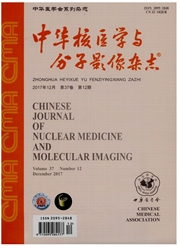

 中文摘要:
中文摘要:
目的:将细胞生物学与PET、SPECT及MRI等影像检测手段结合,评价MSCs移植治疗模型猪缺血性心脏病的疗效并推测其机制。方法按随机数字表将24头猪[(25±5) kg]分为2组:MSCs移植组( n=12)及对照组( n=12)。建立AMI模型,体征平稳后于梗死周边心肌内注射自体MSCs(2×107,2 ml),对照组以相同方法注射等体积无血清Iscove改良的Dulbecc培养基(IMDM)培养液。 MSCs移植后1、4周时行PET及SPECT检测心肌葡萄糖代谢及心肌血流灌注情况,分别计算18 F?FDG平均信号强度( MSI)、SRS、SRS百分比( SRS%)等;采用MRI检测左心室功能,计算2组LVEF、ESV、左心室每搏输出量( SV)及心输出量( CO)等。4周时影像检测后处死动物,取心肌组织行HE及Masson染色。2组间比较采用非参数Mann?Whitney u检验,组内比较采用非参数Wilcoxon检验。结果(1)移植1周时MSCs移植组最低MSI低于对照组(22.10±3.18与35.70±3.02;z=-2.65,P<0.05),总MSI亦低于对照组(1013.50±29.37与1084.00±21.15;z=-1.97,P<0.05),其余指标2组间差异均无统计学意义。移植4周时,MSCs移植组最低MSI(34.00±4.25)较1周时明显提高(z=-2.81, P<0.01),总MSI(1075.50±28.30)亦明显提高(z=-2.80,P<0.01);SRS及SRS%较1周时减低[20.20±2.24与23.80±1.58,(29.80±3.31)%与(35.10±2.34)%;均z=-2.08,均P<0.05];左心室梗死区(MSI低于70的范围)内节段平均MSI较1周时明显增加(56.25±3.54与48.14±2.71;z=-2.80,P<0.01)。对照组上述参数4周时均较1周时改善,但差异均无统计学意义(均P>0.05)。(2)移植1周时2组血流灌注参数无明显差异,4周时各血流灌注指标及灌注缺损范围均无明显改变。(3)移植1周时2组心功能参数无明显差异;移植4周时,MSCs?
 英文摘要:
英文摘要:
Objective To evaluate the effect and mechanism of bone morrow MSCs transplantation in swine with AMI by cell biology and molecular imaging methods including PET/CT, SPECT, and MRI. Methods Twentyfour Chinese miniswine ( ( 25 ± 5 ) kg ) were randomly divided into 2 groups: MSCs group ( n=12) and control group ( n=12) . Myocardial infarction was induced in swine hearts by occlusion of the LAD. Thirty minutes later, the MSCs group received autologous MSCs transplantation through intramyocardial injection into the periinfarcted areas (2×107,2 ml) and the control group was subjected to cell culture medium in the same way. At the 1st and 4th weeks after MSCs transplantation, myocardial glucose metabolism, myocardial perfusion and cardiac function were evaluated in the two groups through PET/CT, SPECT and MRI. The minimum FDG mean signal intensity ( MSI ) , summed MSI, SRS, SRS%, LVEF, ESV, stroke volume ( SV) and cardiac output ( CO) were calculated. On the 4th week, HE and Masson′s Trichrome stains were performed. MannWhitney u test and nonparametric Wilcoxon test were used. Results (1) As evaluated by PET in the 1st week, the MSI and summed MSI in MSCs group were less than those in control group ( 22. 10 ± 3. 18 vs 35. 70 ± 3. 02, z=-2. 65; 1 013. 50 ± 29. 37 vs 1 084. 00 ± 2115, z=-1.97;both P〈0.05) . Compared to the minimum MSI and summed MSI in the 1st week, those in MSCs group increased significantly (34.00±4.25, z=-2.81;1 075.50±28.30, z=-2.80;both P〈001) in the 4th week. SRS and SRS% decreased in the 4th week compared to those in the 1st week (20.20±2.24 vs 23.80±1.58, (29.80±3.31)% vs (35.10±2.34)%;both z=-2.08, both P〈0.05). The averaged MSI in left ventricular infarction area (MSI〈70) also increased (56.25±3.54 vs 48.14±2.71;z=-2.80, P〈0.01). The abovementioned parameters had no statistically significant differences in the 4th week compared to those in the 1st week in the control group (all P〉0.05). (2) In t
 同期刊论文项目
同期刊论文项目
 同项目期刊论文
同项目期刊论文
 期刊信息
期刊信息
